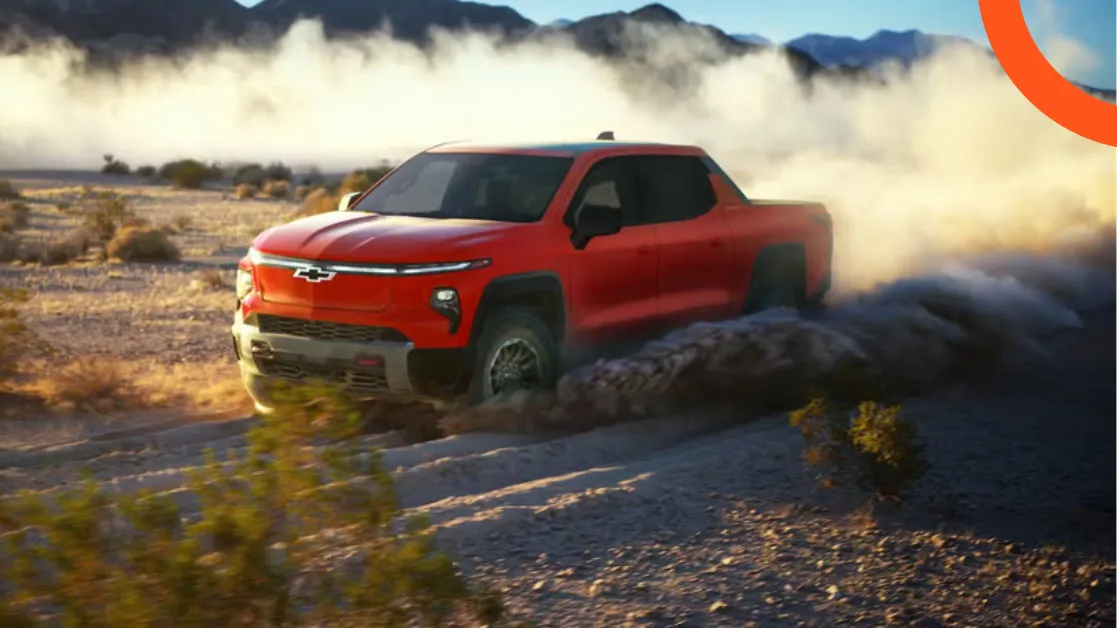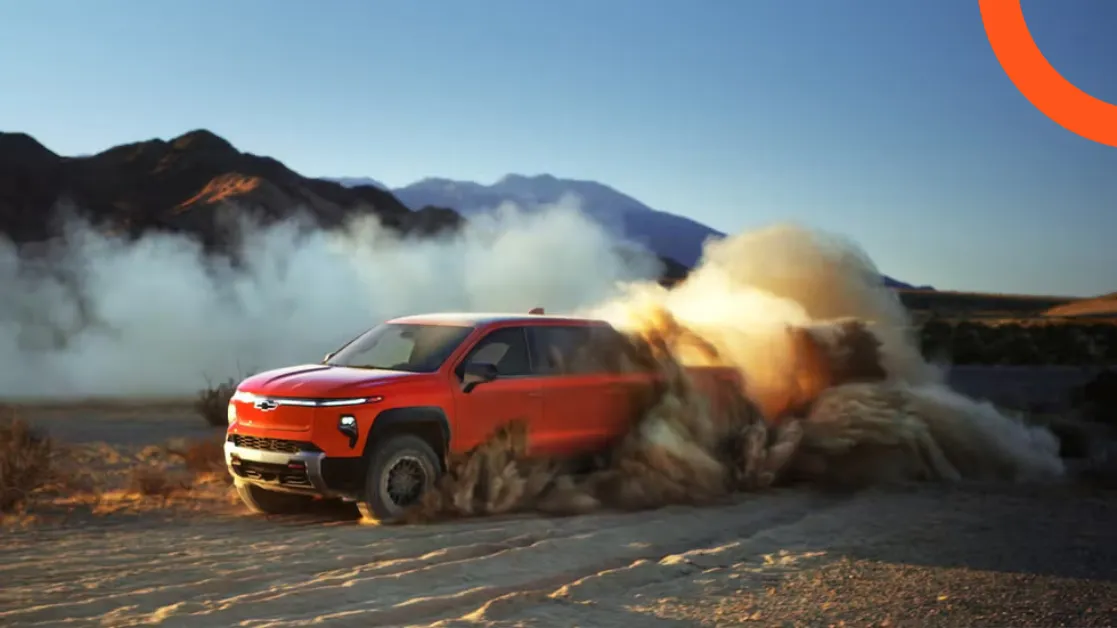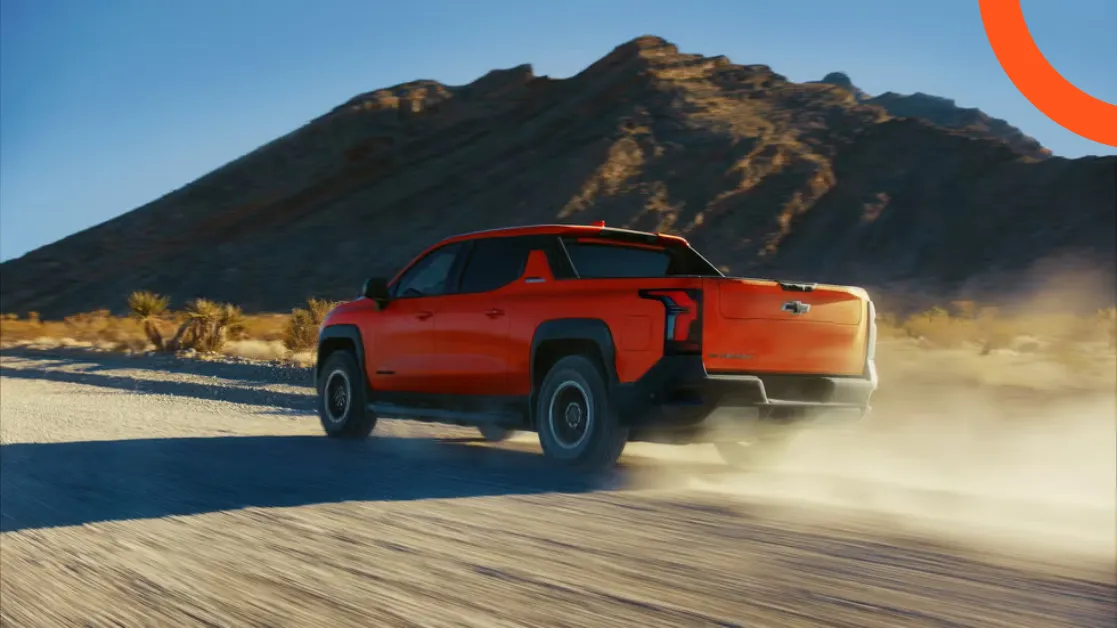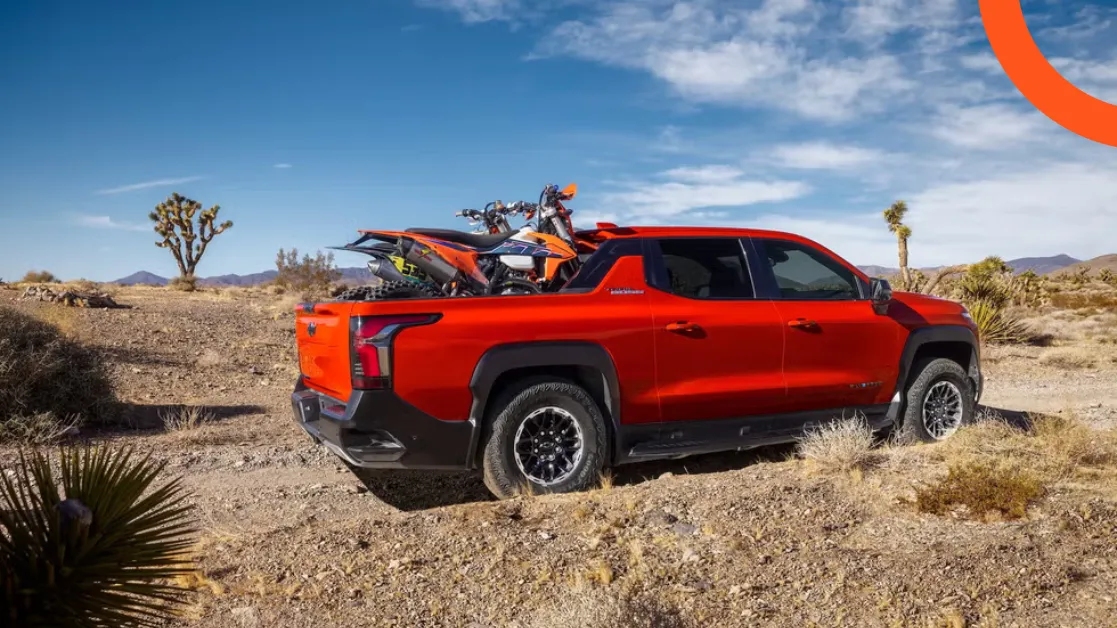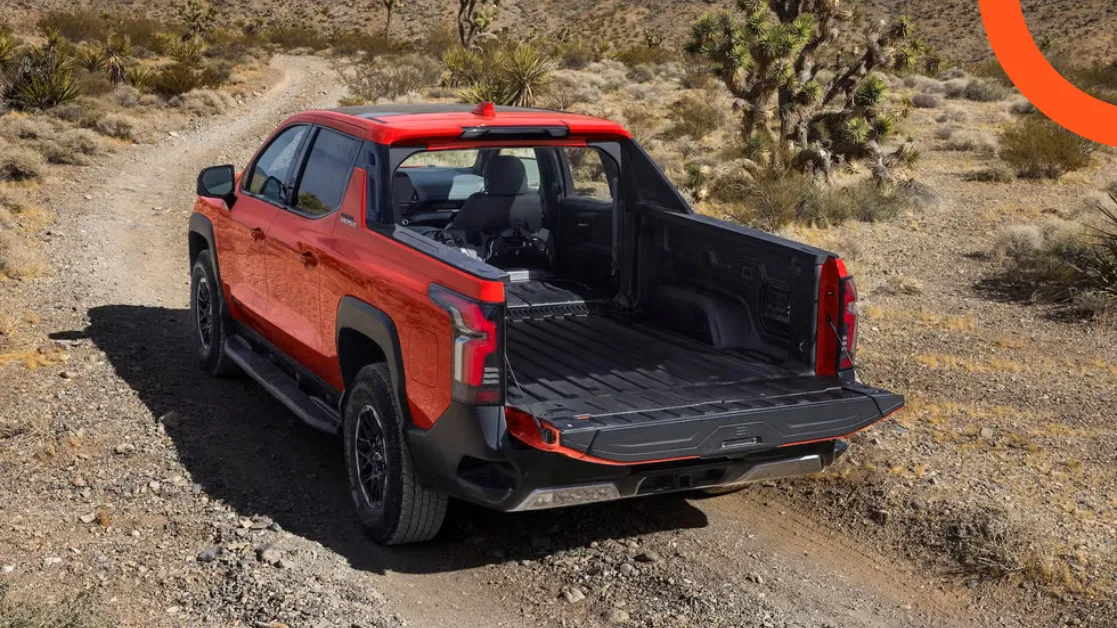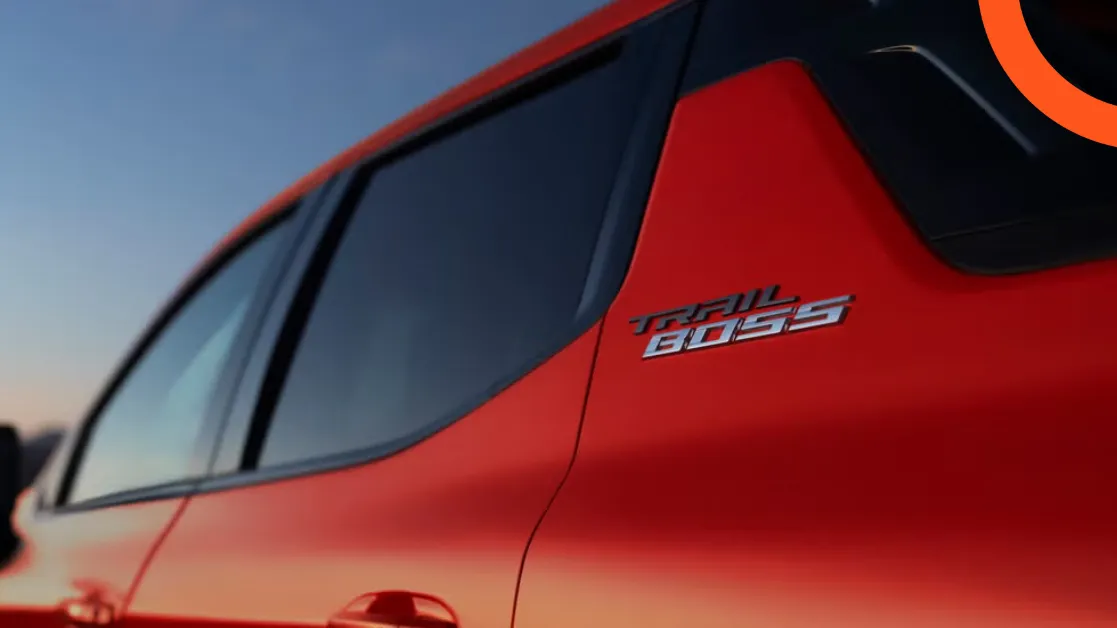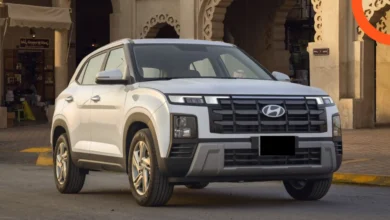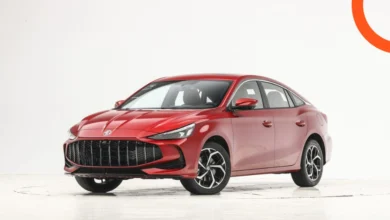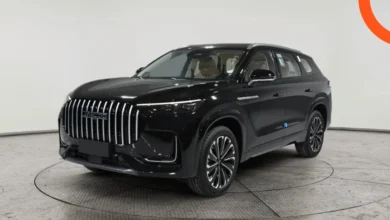2026 Chevrolet Silverado EV: 1,704 km on a Single Charge
Chevrolet is preparing to launch the most off-road-focused version of its electric Silverado EV pickup truck, the Trail Boss model for 2026, serving as a turning point in the capabilities of full-size electric trucks off-road. After establishing its position with a remarkable operating range and record achievements in distance travel, the Trail Boss adds a new layer of power, durability, and off-road capability while maintaining competitiveness on paved roads. By raising the vehicle by 2 inches and featuring massive 35-inch tires and a standard four-wheel steering system, the Trail Boss promises a confident and considered driving experience on sand, gravel, mud, and rugged trails, as well as in everyday city maneuvers.
Browse Chevrolet Silverado 2026 Cars at the Best Prices
Power and Performance
| Specifications | Details |
|---|---|
| Maximum Power (with Max Range Battery) | 725 hp |
| Torque (with Max Range Battery) | 775 lb-ft |
| Range (Max Range Battery) | 478 miles (approximately 769 km) |
| Range (smaller battery) | 410 miles (approximately 660 km) |
| Turning Diameter | 42.2 feet (12.86 meters) |
| Towing Capacity (with smaller battery) | 12,500 lbs (approximately 5,670 kg) |
| Payload (with smaller battery) | 2,100 lbs (approximately 953 kg) |
| Factory Lift | 2 inches (5 cm) |
| Tire Size | 35 inches |
| Overall Length | 233 inches (approximately 5.9 meters) |
| Approximate Weight of Max Range Versions | Approximately 9,000 lbs (about 4,082 kg) |
The 2026 Silverado Trail Boss electric truck, when choosing the Max Range battery package, delivers strong performance with 725 horsepower and 775 lb-ft of torque, ensuring confident acceleration and momentum on both paved roads and rugged trails. Despite the large tires and lift that increase aerodynamic resistance and friction, which may consume some energy, the truck still offers a practical operating range thanks to energy management and system efficiency. It maintains its competitiveness in daily driving by providing better control thanks to four-wheel steering and an optimized turning diameter, which is crucial for assuring drivers that the off-road version does not impose harsh compromises in the city or on highways.
Range and Efficiency: Between Reality and Record Numbers
Trail Boss Range on Paper
The larger battery pack in the Silverado EV Trail Boss allows for a range of up to 478 miles (approximately 769 km) as advertised for this version when selecting Max Range, while the smaller pack provides a range of up to 410 miles (approximately 660 km). These numbers take into account the nature of the platform, thermal management efficiency, tire size, and vehicle height; off-road tires and increased ground clearance negatively impact aerodynamics and energy consumption, yet the Trail Boss remains within a competitive operational capability for daily driving and long trips on paved roads before recharging.
Record Achievement… Under Special Conditions: 1,704.6 kilometers on a Single Charge
Chevrolet recorded an impressive figure with the 2026 Silverado EV and Max Range Work version, achieving 1,704.6 kilometers on a single charge, surpassing the previous record held by the Lucid Air Grand Touring of 1,205 kilometers. However, the conditions of achieving this number reveal a highly controlled testing environment: a constant speed between 32 and 40 km/h, alternating drivers every hour, without using adaptive cruise control, removing the spare tire to reduce weight, optimizing wheel angles, and installing a rear cover to improve aerodynamic drag. Therefore, while the result is impressive from an engineering standpoint, it does not reflect an ordinary daily driving pattern.
This gap between record figures and real-world use underscores the fact that the official range according to the Environmental Protection Agency (EPA) for this vehicle version is 793 kilometers. Unlike Lucid’s test, which was conducted on a variety of mountainous and fast roads, Chevrolet was tested under more controlled and regulated conditions. The practical conclusion for the driver: maximum figures are useful for understanding platform efficiency and technical limits, but daily energy planning and distance should be based on realistic estimates closer to EPA standards and the nature of actual trips.
Price in Saudi Arabia
The prices for the 2026 Chevrolet Silverado EV start in Saudi Arabia at approximately 200,000 SAR for the Standard Range Work Truck, then the Standard Range LT at around 231,000 SAR, moving up to the Extended Range Work Truck, priced at approximately 251,000 SAR, followed by the Extended Range LT at a price of about 262,000 SAR, and finally the Extended Range Trail Boss at approximately 265,000 SAR.
The Max Range versions start from 281,000 SAR for the Work Truck, then 327,000 SAR for the Trail Boss, and reach up to 337,000 SAR for the highest in the group, the Max Range LT, which provides the maximum driving range. Prices vary based on the selected trim, and for more details, browse the Chevrolet Silverado EV 2026 section on the car website through the link below.
Browse Chevrolet Silverado 2026 Cars at the Best Prices
The following table outlines the prices for Chevrolet Silverado EV 2026 trims in Saudi Arabia:
| Trim | Price in SAR |
|---|---|
| Standard Range Work Truck | 200,000 |
| Standard Range LT | 231,000 |
| Extended Range Work Truck | 251,000 |
| Extended Range LT | 262,000 |
| Extended Range Trail Boss | 265,000 |
| Max Range Work Truck | 281,000 |
| Max Range Trail Boss | 327,000 |
| Max Range LT | 337,000 |
Engineering and Exterior Design for Off-Road
Redesigned Front End and Tow Hooks
The Trail Boss features a redesigned front end to improve the approach angle, which is critical for the front to overcome obstacles without scraping. This front end includes red tow hooks, which serve as practical and straightforward tools for recovery if the vehicle gets stuck in soft sand or is bogged down in mud layers. Despite their evident aesthetics, these hooks are a functional safety element, reflecting an engineering awareness of the demands of off-road driving. However, it should be remembered that the Max Range battery versions of the Silverado EV weigh about 9,000 lbs (approximately 4,082 kg), meaning that towing and recovery operations require strong equipment and capable support vehicles, especially in deep muddy environments.
Chassis, Wheelbase, and Dimensions
The Silverado EV Trail Boss measures about 233 inches (5.9 meters) in length, and with this length, along with a large wheelbase and considerable width, no full-size pickup truck is inherently ideal for every off-road scenario. However, the Trail Boss cleverly challenges this equation with mentioned enhancements to mitigate the effects of length on turning capability and obstacle clearance. Improving the approach angle, coupled with large tires and elevated height, gives the driver extra confidence when facing boulders or sharp edges and allows for more precise path selection to avoid sudden bottoming out.
Four-Wheel Steering System and Sidewinder Mode
The four-wheel steering system comes standard with the Trail Boss, a differentiating factor in control and maneuverability. Despite the large 35-inch tires, the truck can turn entirely within a diameter of 42.2 feet (12.86 meters), making it more agile than most full-size trucks in tight spaces. This result translates not only into easier navigation through winding off-road paths but also provides greater comfort when parking or maneuvering in crowded settings or when steering trailers.
The Trail Boss also features the Sidewinder mode, allowing all four wheels to rotate in parallel for diagonal movement when needed. This capability is not just an engineering show-off but a practical solution in scenarios of sideways slipping on sand or to escape from tight tracks when progress or reverse in a traditional angle is impossible, as it can also be utilized to bypass an exposed rock or tree trunk without a complete repositioning, saving time and effort and reducing the chances of collision.
The Identity of Trail Boss and Why It Matters
The Trail Boss badge within the Silverado EV lineup signifies a conscious focus on the details of tough usage, starting with an additional 2-inch (5 cm) lift at the front and rear from the factory, a seemingly minor adjustment but one that has a significant impact in reality; it provides more clearance beneath the body to tackle angles and rises without scraping, improves the ability to overcome obstacles and cross deep potholes. This addition is combined with 35-inch tires, giving a larger contact surface and better floatation over sandy and muddy surfaces, along with taller sidewalls to help absorb shocks and stabilize the vehicle on uneven terrain, yet Trail Boss does not stop at off-road hardware; it benefits from standard four-wheel steering to keep the handling of the truck’s mass and dimensions under control even in tight spaces.
Suspension and Hydraulic Rebound Control System
The suspension system in the Trail Boss 2026 stands out with hydraulic rebound control, a technical detail that directly impacts driving quality on off-road, dirt, and gravelly surfaces. Rapid vibration sequences can lead to the phenomenon known as “choppiness” or successive rebound, causing tires to lose grip and shake the frame. Hydraulic rebound control works to calm this motion and reduces wheel rebounds during compression recovery, improving tire stability on the surface and providing the driver with more precise control and more consistent braking distance on varying surfaces.
Practically, this means a less tiring trip for the driver and passengers on long journeys over successive undulations, minimizing the likelihood of sudden loss of traction when crossing closely spaced speed bumps. Coupled with large tires and added lift, the Trail Boss’s suspension system becomes better prepared to absorb repeated shocks without excessive “bouncing back” that disrupts response.
Weight and Risk Management on Off-Road
Although the Trail Boss is designed to tackle challenges, physics cannot be defeated; trucks equipped with the Max Range battery weigh around 9,000 lbs, which grants outstanding stability at medium and high speeds on paved roads but can become a challenge in deep mud or soft sand, where immersion becomes more probable if surfaces lack sufficient traction. Therefore, selecting paths carefully, avoiding unverified muddy potholes, and utilizing solid paths as much as possible are all behaviors that reduce the risks of sudden immersion.
In case of getting stuck, the front tow hooks become crucial rescue tools, but the heavier weight necessitates appropriate towing equipment and a capable rescue partner; otherwise, recovery operations may turn into a risk. Thus, technological capabilities such as the Sidewinder mode gain added value; they may help alleviate angles of exit from a predicament before resorting to full towing.
The Takeaway for Daily Users
For the everyday user navigating within the city or traveling between towns, relying on official figures and realistic conditions is the way to better decisions. In off-road driving scenarios where energy consumption varies significantly with surface nature, rolling resistance, and elevations, speed management and route planning become more important. Nevertheless, the announced range for the Trail Boss in both battery packs remains among the figures capable of meeting diverse needs without excessive worry, especially if usage ranges between work tasks and recreational trips on paved roads with rugged intervals.
Towing and Payload: Why Might You Choose the Smaller Battery?
Data shows that selecting the smaller battery pack does not always mean a compromise in hard work; on the contrary, its lighter weight allows for greater towing and payload capacities, reaching 12,500 lbs (approximately 5,670 kg) for towing and 2,100 lbs (approximately 953 kg) for payload. These figures realistically mean that the Trail Boss with the smaller pack can be a practical choice for towing medium to large trailers and transporting considerable payloads while retaining a range of up to 410 miles (approximately 660 km). It’s an innovative balance between efficiency and function: sufficient range for daily work and medium distances, with strong loading and towing performance.
Of course, the choice of the package is suitable for the nature of usage. If the greater focus is on long continuous trips between cities, the larger package with a range of 478 miles might weigh in favor. However, if work requires higher towing and payload within slightly shorter distance ranges, the smaller package offers a practical and straightforward proposal. In all cases, the Trail Boss maintains a high usability thanks to the four-wheel steering and its maneuverability compared to its size.
Usability on Paved Roads
Despite the off-road enhancements, the Silverado EV Trail Boss still appears to be a capable and competitive truck on paved roads. A significant part of this is attributed to the four-wheel steering system that reduces the turning circle and makes lane changes and turns smoother, along with the precise tuning of the suspension which limits bouncing and provides a balanced response when crossing speed bumps or expansion joints. The large tires typically add some stiffness and noise, but in return, the driver gains solid stability and a strong presence on the road, translating into a feeling of safety and control.
This combination means that the Trail Boss does not isolate itself in the “weekend warrior” category alone, but can also serve as a reliable daily companion for commuting and traveling, especially for those who appreciate the elevated driving position and the stature of a large truck on the road, with maneuverability that surprises many for such size.
Conceptual Comparison with Other Large Trucks
Large trucks typically suffer from wide turning circles and high weights that limit their maneuverability in tight off-road paths. The Silverado EV Trail Boss addresses these points with practical tools: four-wheel steering reduces the turning radius to 42.2 feet, 35-inch tires ensure better grip on soft surfaces, and a 2-inch lift improves ground clearance. These additions, compared to industry standards, provide tangible solutions to three chronic problems: maneuverability, grip, and collision with obstacles. The result is that the driver finds themselves less reliant on forced momentum and more dependent on precision in choosing the line and path.
Tips for Maximizing the Benefits of Trail Boss
- Utilize the four-wheel steering in tight terrains: approach corners at a slightly wider angle and then benefit from the rear axle rotation to minimize the turning distance.
- Use Sidewinder mode when you need lateral movement to bypass a side obstacle or to exit a low-traction surface without strenuous repositioning.
- Visually check muddy trails before delving deep: the heavy weight is an advantage on firm surfaces but can be a hurdle in loose mud.
- Leverage the lift and large tires to tackle approach angles smartly: proceed slowly over edges to allow the suspension to absorb impacts without annoying rebound.
- For heavy tasks, consider the smaller battery pack if your priority is towing and payload within familiar working distances.
- On paved roads, maintain smooth and balanced driving to optimize efficiency and battery range, especially with larger off-road tires.
- Use tow hooks as a last resort after testing maneuverability with Sidewinder mode and safe exit techniques.
Frequently Asked Questions
What distinguishes the 2026 Silverado EV Trail Boss from other versions?
The Trail Boss focuses on off-road driving excellence; it receives a factory lift of 2 inches (5 cm) and massive 35-inch tires, along with a redesigned front end and red tow hooks. It also comes with standard four-wheel steering and Sidewinder mode for diagonal movement, enhancing its maneuverability in tight trails compared to a full-size truck.
What is the turning radius of the Trail Boss and how does it affect daily usage?
Despite the larger tires, the Trail Boss can turn within a diameter of 42.2 feet (12.86 meters). This figure allows for easier maneuvers in parking spaces and internal roads as well as turning in narrow rugged paths, reducing the need for repeated forward and backward adjustments.
What are the available towing and hauling capacities?
When selecting the smaller battery pack, the Trail Boss allows for a towing capacity of 12,500 lbs (approximately 5,670 kg) and a payload capacity of up to 2,100 lbs (approximately 953 kg). This is linked to the lesser weight allowing for better operational weights without sacrificing overall system balance.
What is the available range with each battery pack?
The Max Range battery option provides a range of up to 478 miles (approximately 769 km), while the smaller battery option provides a range of up to 410 miles (approximately 660 km). Expect variances in real-world conditions depending on driving style and road nature.
What are the power and torque figures in the Trail Boss?
When fitted with the Max Range battery pack, the power reaches 725 hp with a torque of 775 lb-ft, ensuring strong performance on both paved and off-road surfaces.
What is the approximate weight of Silverado EV versions equipped with the Max Range battery?
These versions weigh close to 9,000 lbs (approximately 4,082 kg). This weight provides high stability, but it necessitates additional caution in deep muddy environments to avoid sinking.
What is the practical benefit of Sidewinder mode?
Sidewinder mode allows for parallel rotation of all four wheels for diagonal movement. This is beneficial for escaping slippery areas or bypassing side obstacles without the need for extensive forward/backward maneuvering, while also helping correct the truck’s path within tight corridors.
Has the approach angle been improved on the Trail Boss?
Yes, the new front design includes improvements that enhance the approach angle, allowing the front to overcome difficult obstacles without scraping and features red tow hooks that are useful in recovery operations.
Do the range records reflect daily usage?
The Silverado EV 2026 Max Range Work recorded a distance of 1,704.6 kilometers on a single charge under highly controlled conditions (speeds of 32–40 km/h, alternating drivers, removing the spare tire, optimizing wheel angles, and a rear cover). The official range according to the EPA for that version is 793 kilometers, indicating that the record does not reflect traditional daily driving but highlights the platform’s capabilities under ideal conditions.
Does the Trail Boss suit paved roads, or is it solely for off-road?
Despite its off-road focus, the Trail Boss appears capable and competitive on paved roads, thanks to its four-wheel steering and suspension tuning. Thus, it provides a balanced option for those seeking a single truck that covers daily work and adventure during leisure.
Summary
The Chevrolet Silverado EV Trail Boss 2026 reflects a practical philosophy, granting the full-size electric truck realistic tools to excel off-road without sacrificing daily usability. The extra 2-inch lift, 35-inch tires, hydraulic rebound control, four-wheel steering with Sidewinder mode, all integrate to dissolve many of the restrictions that have long plagued large trucks in complex terrains. On the other hand, the Trail Boss maintains its competitiveness on paved roads and offers range options that suit various driving patterns: 478 miles with the Max Range battery for those prioritizing long trips, and 410 miles with the smaller pack for those balancing towing/payload with range.
The Silverado EV’s record achievement of covering 1,704.6 kilometers on a single charge illustrates what the platform can achieve under optimal conditions; however, it does not replace reliance on realistic estimates like the EPA range of 793 kilometers for the Max Range Work version when planning daily trips. Ultimately, the Trail Boss is not just a version lifted with larger tires; it is an engineered system designed to provide better traction, confidence, and maneuverability in off-road scenarios while keeping performance and range within limits that make it truly practical for those living between work on the road and fun in the trails.
